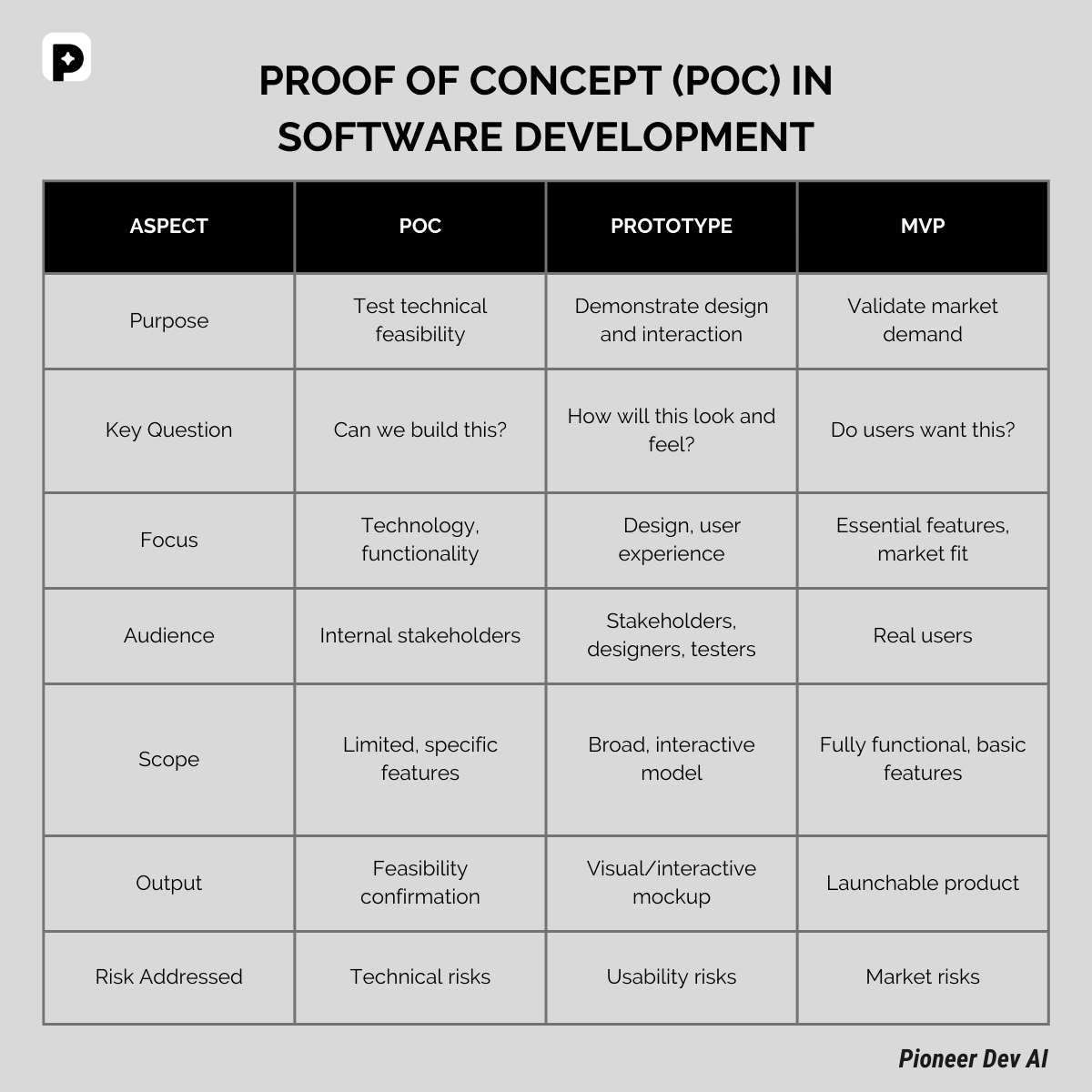Everything You Need to Know About Proof of Concept (PoC) in Software Development
Risk reduction and validation are paramount in ensuring the success of any software development project. This is where a Proof of Concept (PoC) in software comes into play. A PoC is a crucial early-stage demonstration that helps teams determine whether an idea is feasible and worth pursuing.
This is to minimize risks before diving into full-scale development. In this article, we’ll dive deep into the significance of PoCs, explore their benefits for software development, and walk through the essential steps involved in creating a successful PoC to set your project up for success.
What is a Proof of Concept (PoC)?
A Proof of Concept (PoC) is a preliminary demonstration designed to prove the feasibility and viability of a concept or idea in software development . A PoC in software focuses on testing whether a particular technology or solution is achievable and functional before committing to a full-scale project. It is a vital step in ensuring that the idea holds potential and can be developed effectively.
Key Differences: PoC vs. Prototype vs. MVP
While PoC software, prototypes, and Minimum Viable Products (MVPs) all aim to validate concepts, they differ in scope and purpose:
- PoC: A proof that a concept can work, often focusing on a single, specific aspect of the idea.
- Prototype: A basic version or mock-up of the product that demonstrates the design or functionality.
- MVP: A minimal version of the product with enough features to satisfy early users and gather feedback for future development.
We will dive deeper into this in the succeeding parts of the article.
Purpose of PoC
The core purpose of a PoC in software is to validate technical feasibility, assess market potential, and reduce risks early in the development process. By testing key elements before full development begins, PoCs help developers avoid costly mistakes, make more informed decisions, and ensure that the software has a solid foundation for future success.
Benefits of PoC in Software Development
A PoC in software is more than just an early-stage test; it’s a strategic tool that offers significant benefits across different facets of the development process. By validating ideas early on, PoC software allows development teams to optimize resources, gain stakeholder support, and make decisions with confidence.
Risk Mitigation
One of the primary benefits of PoC in software is its ability to mitigate risks. By identifying potential issues early on, a PoC reduces the likelihood of unexpected challenges later in the project, which can lead to costly delays or even failure.
According to a study by McKinsey, approximately 45% of software projects exceed their budgets due to unforeseen issues, many of which can be addressed with early PoC validation.
Google’s team used a PoC approach when launching Google Duplex , their AI-driven customer service tool. The PoC identified early AI limitations, allowing Google to adjust resources and avoid delays in the product’s final rollout.
Optimization
A PoC in software development helps teams save time and money by testing ideas before full-scale development.
This is crucial because Gartner, Inc. predicts that by 2026, over 80% of businesses will have implemented generative AI application programming interfaces (APIs) or models, or will have deployed applications powered by generative AI in production settings—a substantial increase from less than 5% in 2023.
Stakeholder Confidence
Early validation through PoC software builds trust and confidence among investors and stakeholders. A successful PoC demonstrates technical viability and market potential, helping stakeholders feel more secure in funding the project.
For instance, Slack conducted a PoC to show potential investors the viability of its messaging platform, which proved instrumental in securing initial funding and setting the stage for its success.
When Should You Use a PoC in Software Development?
A PoC in software development is invaluable when exploring new ideas or technologies that carry uncertainty or risk. Here are scenarios where a PoC software approach can make a meaningful impact:
New Technologies
If your project involves integrating complex or unfamiliar technologies, using a PoC in software can help test how these technologies will function within your product. This approach minimizes unexpected technical issues, especially when dealing with innovations like AI or blockchain, where early assessment can guide development.
Unclear Feasibility
When there is doubt about whether a concept is technically feasible, a PoC software test provides clarity. Conducting a PoC enables teams to validate critical aspects of a concept before committing significant resources, helping avoid potential roadblocks that might emerge in full-scale development.
High-Risk Projects
In projects with high stakes—where securing funding or obtaining stakeholder approval is essential—a PoC in software provides early validation that can reduce risks. Demonstrating feasibility early on not only builds confidence but can also be pivotal in acquiring the support needed to move forward with development.
PoC vs. Prototype vs. MVP: What’s the Difference?

Understanding the distinctions between PoC in software, prototypes, and Minimum Viable Products (MVPs) is essential for effective project planning. Each serves a unique purpose in the development process and is used at different stages to validate ideas and reduce risk.
PoC
A PoC (Proof of Concept) is primarily concerned with testing the technical feasibility of a concept. It answers the question: Can this idea be implemented as envisioned? By focusing on functionality, a PoC in software development verifies if a particular feature, technology, or approach is viable, allowing teams to identify potential challenges early.
Prototype
A prototype is a working model that provides a visual and interactive demonstration of the product’s design, user experience, and functionality. While a prototype may not be fully functional, it gives stakeholders a sense of how the final product will look and operate, making it easier to gather feedback and refine the design before moving forward.
MVP
The Minimum Viable Product (MVP) is a version of the product that includes only the essential features needed to meet user needs and test the market. Unlike a PoC software or prototype, an MVP is fully functional and ready for initial user testing. It allows teams to validate product-market fit and gather feedback from real users, which helps drive future development.
By strategically using a PoC in software, a prototype, or an MVP, development teams can minimize risks and maximize resources, ensuring a smoother path from concept to launch.
Conclusion
In software development, a Proof of Concept (PoC) is a valuable tool that validates an idea’s feasibility before resources are invested. Throughout this article, we’ve explored the purpose of a PoC in software, how it differs from prototypes and MVPs, and the scenarios where it’s most beneficial—particularly when navigating new technologies, addressing unclear feasibility, or handling high-risk projects.
By focusing on early validation, PoCs help mitigate risks, optimize resources, build stakeholder trust, and support faster, more informed decision-making.
If you’re considering hiring a software agency , take the time to assess whether a PoC could help validate your idea. By addressing potential challenges upfront, a PoC can provide clarity and direction, helping set your project up for success from the very beginning.
At Pioneer Dev AI , we understand the challenges involved in bringing new software concepts to life. Our team specializes in building tailored Proof of Concept (PoC) solutions, helping you validate ideas efficiently and mitigate risks before full-scale development.

